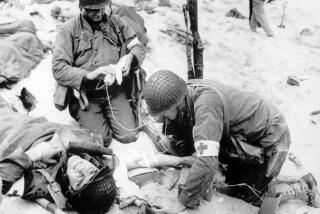200 years of surgical history, as told by Dr. Atul Gawande
- Share via
Paging all Atul Gawande fans! Your favorite doctor-journalist is out with a new history on his own field: surgery.
The article – part of a yearlong series celebrating the 200th anniversary of the New England Journal of Medicine – begins in 1812, when the newly established periodical is called the New England Journal of Medicine and Surgery, and the Collateral Branches of Science. The way surgery was practiced back then was not for the faint of heart.
For starters, anesthesia would not be invented for another 34 years. So surgeons’ ability to improve patients’ health was greatly limited by the amount of pain patients could endure. (Gawande doesn’t mention this, but one hopes that surgeons and their assistants could only take so much of their patients’ pain as well.)
Amputations were a case in point. They were sometimes necessary to save the life of a patient, but they were also “horrific,” Gawande writes:
“Before the discovery of anesthesia, orderlies pinned the patient down while an assistant exerted pressure on the femoral artery or applied a tourniquet on the upper thigh.” He goes on to describe two gruesome procedures that were commonly used to disconnect patients from their lower limbs in less than a minute. “The limits of patients’ tolerance for pain forced surgeons to choose slashing speed over precision.”
That began to change in 1846 with the introduction of “Letheon,” a gas that rendered patients insensitive to pain. Gawande quotes the opening lines of the journal article introducing it to the medical community: “It has long been an important problem in medical science to devise some method of mitigating the pain of surgical operations. An efficient agent for this purpose has at length been discovered.”
The gas (and other anesthetics) caught on, and in time surgeons realized that it gave them the luxury of working more slowly. They began to explore the abdomen, which was previously off-limits. The discovery of powerful pain meds that made recuperation more comfortable also gave surgeons additional leeway.
After surgeons realized the importance of operating in a sterile environment, the discoveries came at a rapid pace, Gawande reports. In the 1880s alone, surgeons for the first time removed an appendix, a brain tumor and part of a thyroid. The very nature of hospitals changed, from warehouses for poor people who were sick into places where patients were made better.
Further breakthroughs included the advent of cardiopulmonary-bypass machines, which allowed surgeons to work on the heart; organ transplantation, starting with kidneys and livers and just recently expanding to faces; and the development of minimally invasive techniques that are easier for the body to withstand.
“We are now in an era in which a teenage boy can undergo reoperation for repair of a severe coarctation of his thoracic aorta percutaneously on a Thursday and be well enough to sprain his ankle playing sports the following Saturday (as my son did not long ago),” Gawande writes. “The technological refinement of our abilities to manipulate the human body has been nothing short of miraculous.”
More than 50 million surgeries are performed each year in the U.S. and a typical American will go under the knife seven times in his or her life. But it’s not hard to image that the days of cutting into patients could be numbered. Nanotechnology may allow tiny devices to be injected or swallowed, then manipulated by doctors – or even fully automated machines, Gawande concludes.
The full article can be read on the New England Journal of Medicine website.
Here’s my favorite anecdote from the article, which takes place in the pre-anesthesia days:
“[British surgeon Robert] Liston operated so fast he once accidentally amputated an assistant’s fingers along with a patient’s leg, according to [historian Richard] Hollingham. The patient and the assistant both died of sepsis, and a spectator reportedly died of shock, resulting in the only known procedure with a 300% mortality.”
Return to the Booster Shots blog.







